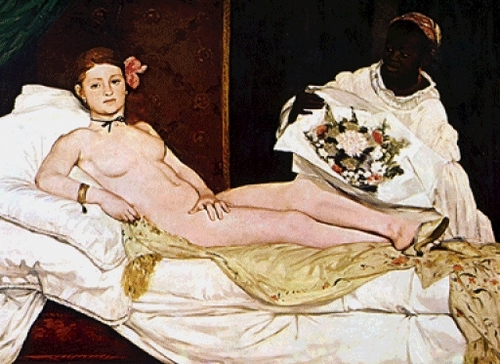The Modern Woman: Sexualization by the Male Gaze
During the 19th century the views depicted in painting were those of the male gaze, not only because most of the painters were men, but also because most of the works depicted male mythical and historical figures, or heroified contemporary men. The purpose of representing women in painting was to support the actions of the male protagonists, or to construct the private/female sphere that separated women from the public one that men were entitled to.
However, during the second half of the 19th century the ideal of beauty changed from male to female, and the way women were represented was revolutionized by a new kind of female nude that was remarkably different from the idealized Salon nude. The paintings presented in this exhibition do not depict women as porcelain-finished mother or allegorical figures; these paintings are rawer representations of the nude modern woman as perceived by the objectifying and sexualizing male gaze.

This painting depicts a group harem scene in which Ingres combines the figure of the nude with an Oriental theme. The main element of eroticism in the painting focuses on the two women caressing each other; also, the black woman in this work is a characterization of the stereotype of savage sexuality attributed to the people of color at the time. The proportions and angles of the women’s body shapes are not realistic representations of the human anatomy, which indicates the dreading of the importance of anatomy in painting by Ingres in the last stages of his career.

Edouard Manet, Olympia, 1863
Olympia was harshly criticized when it was exhibited in the 1865 Salon because in it Manet rejected the defined ideas about sex and gender by depicting a woman’s satisfaction with her sexuality. Not only did his approach of the female nude reject the academic standards of beauty, but also his unpolished, evident, rough brushwork. Olympia’s confrontational look, in defiance to the male gaze, does not allow the viewers to scrutinize her nude figure at ease; during the 19th century, in response to this, the audiences stereotyped her sexuality as animal, as much as that of the black woman next to her.
Olympia was harshly criticized when it was exhibited in the 1865 Salon because in it Manet rejected the defined ideas about sex and gender by depicting a woman’s satisfaction with her sexuality. Not only did his approach of the female nude reject the academic standards of beauty, but also his unpolished, evident, rough brushwork. Olympia’s confrontational look, in defiance to the male gaze, does not allow the viewers to scrutinize her nude figure at ease; during the 19th century, in response to this, the audiences stereotyped her sexuality as animal, as much as that of the black woman next to her.

Gustave Courbet, Sleep, 1866
The banning from public display of this work only served to increase Courbet’s notoriety. In this painting, the artist demonstrated the level of skill of a masterful painter in the polished contours and surface of the lesbian lovers he depicted. The depiction of lesbianism implies a woman’s self-exploration of her body through another woman’s body, which is a striking sign of women’s possession of sexuality; the ability of two women to possess the other’s body emphasizes their ability to possess their own.
Jean-Léon Gérôme, Moorish Bath, 1870
This work represents the quintessential Orientalist painting with an academic approach; the anatomy depicted in this painting refers to that in The Turkish Bath (1862) by Jean-Auguste Dominique Ingres, however, the proportioned and defined shapes follow the academic and naturalistic standards of painting that there were at the time. The erotic nature of this painting is caused by the positioning of an Occidental-looking nude woman next to a bare-breasted black woman in such intimate setting.
Paul Gauguin, Manau Tupapao (The Spirit of the Dead Watching), 1892
Gauguin depicts a young native woman he met during his stay in Tahiti, whom he recognized as Tehura, and a black figure in profile wearing a black robe; this is done with an expressive use of color that is not necessarily related to nature. In his Tahitian diary Noa Noa, Gauguin sexualizes Tehura’s “lovely” expression of fear and uncertainty at the moment of their encounter. Both the description and the depiction of this encounter portray the native woman’s emotional and irrational nature, and the appeal of her unawareness of her sexuality, which characterize the stereotypes of “primitivism” and misogyny that there were at the time.
-AC

No hay comentarios:
Publicar un comentario